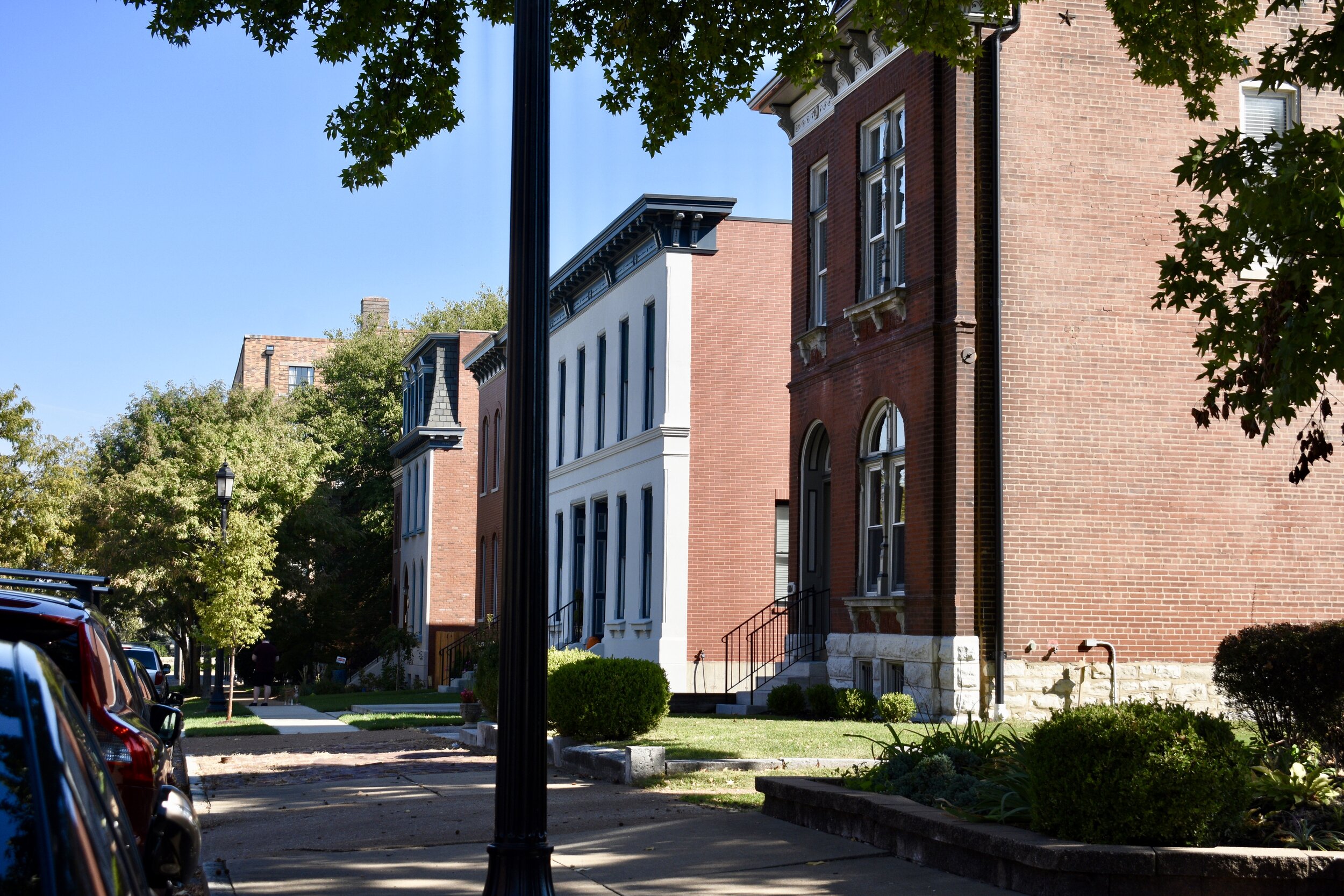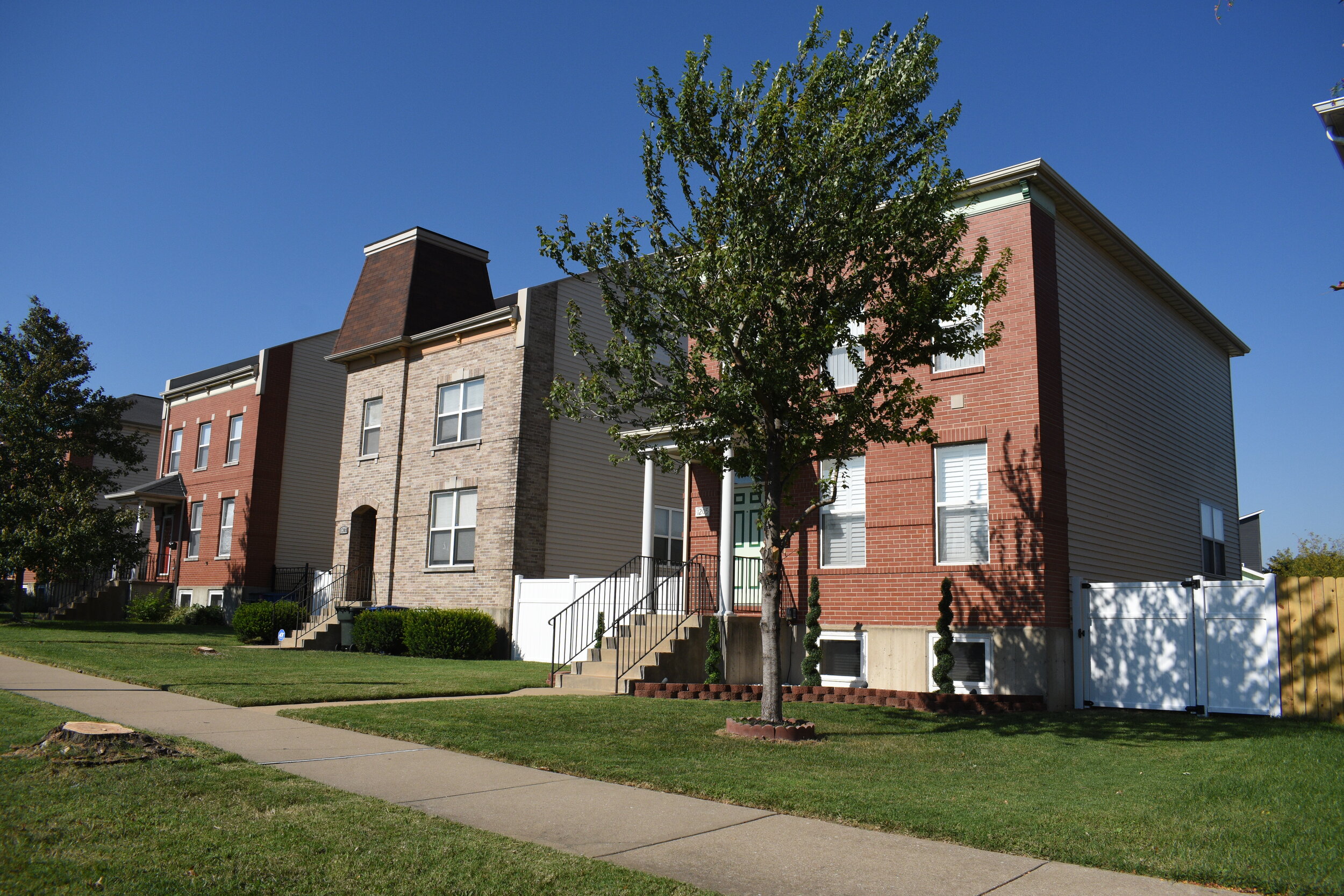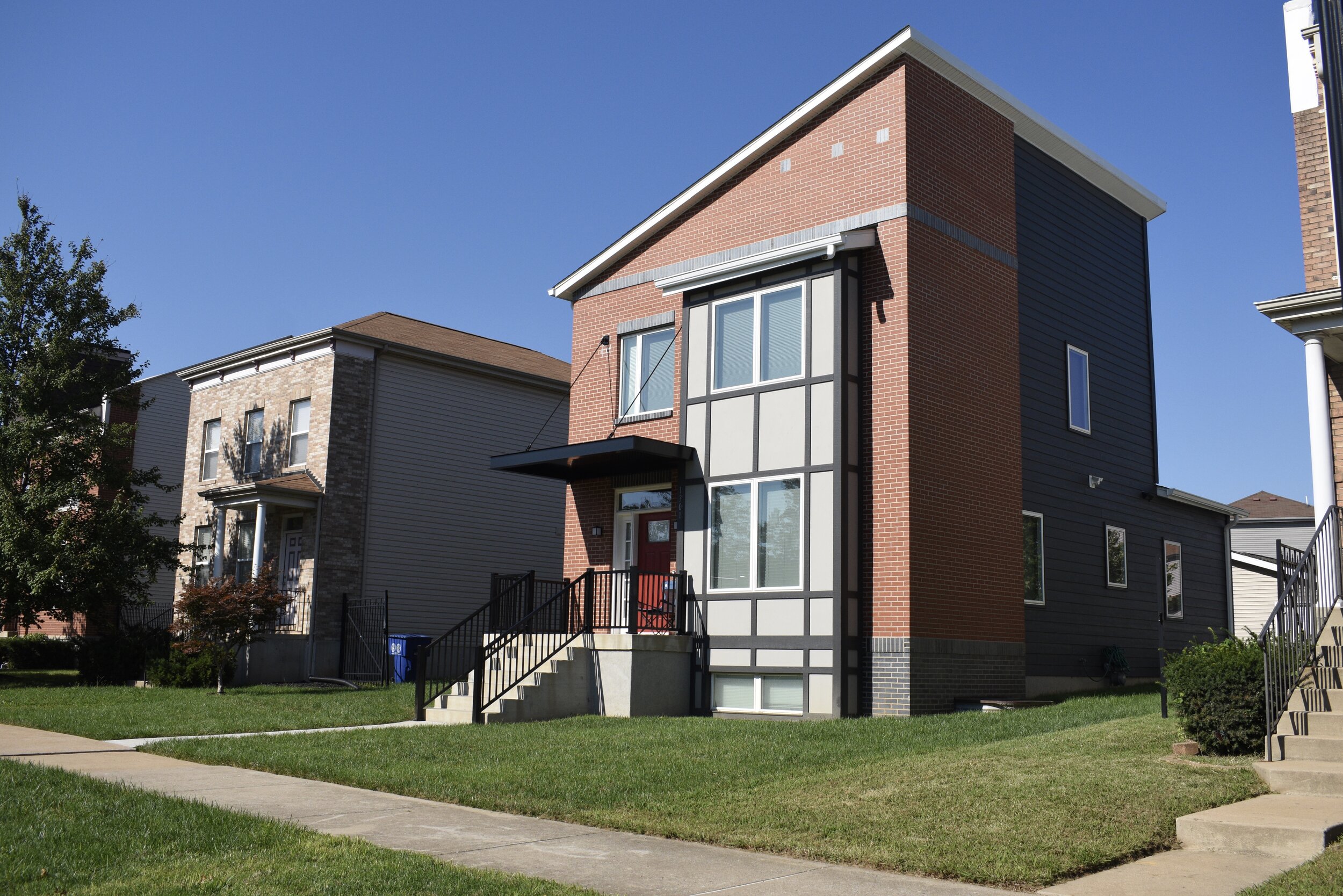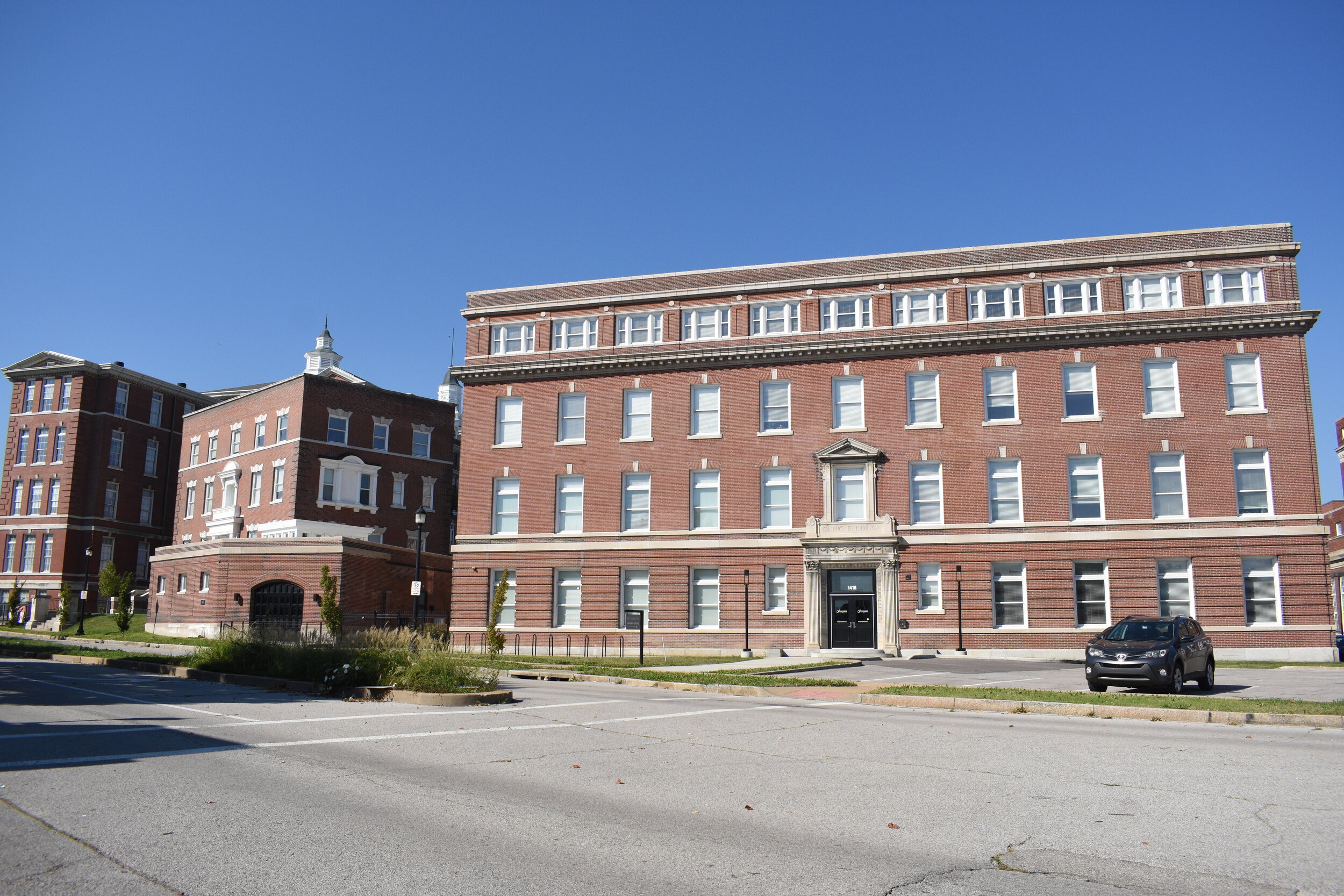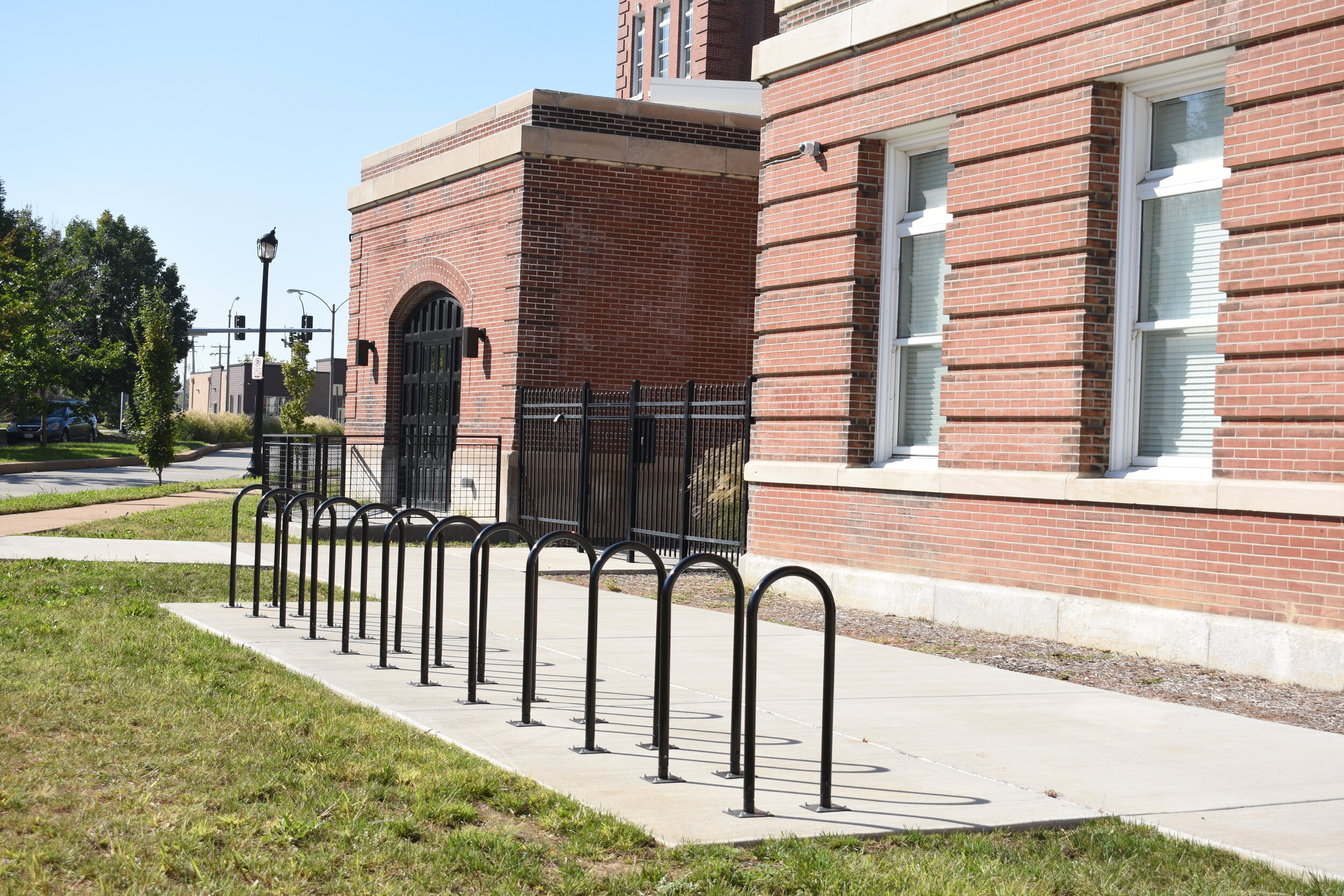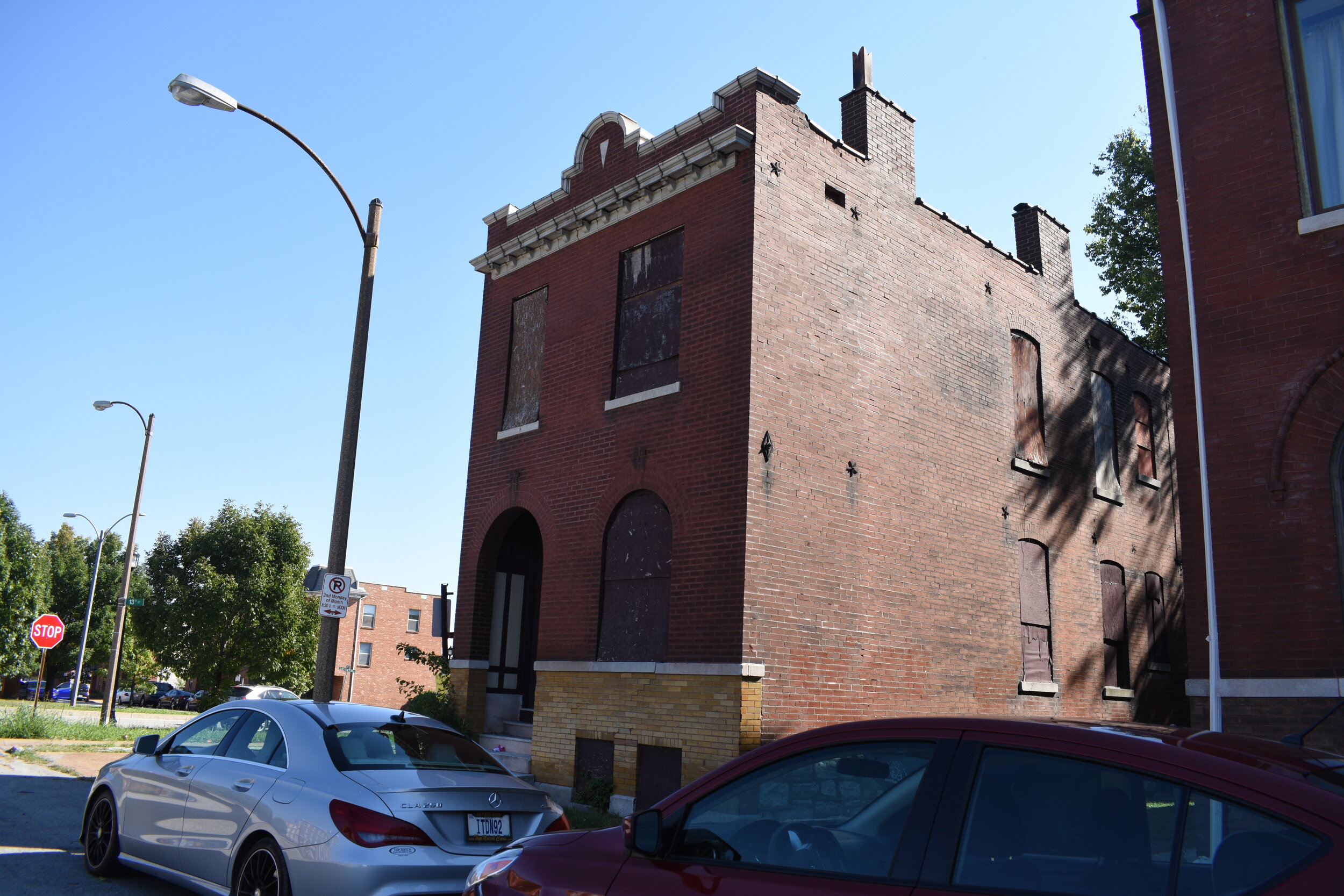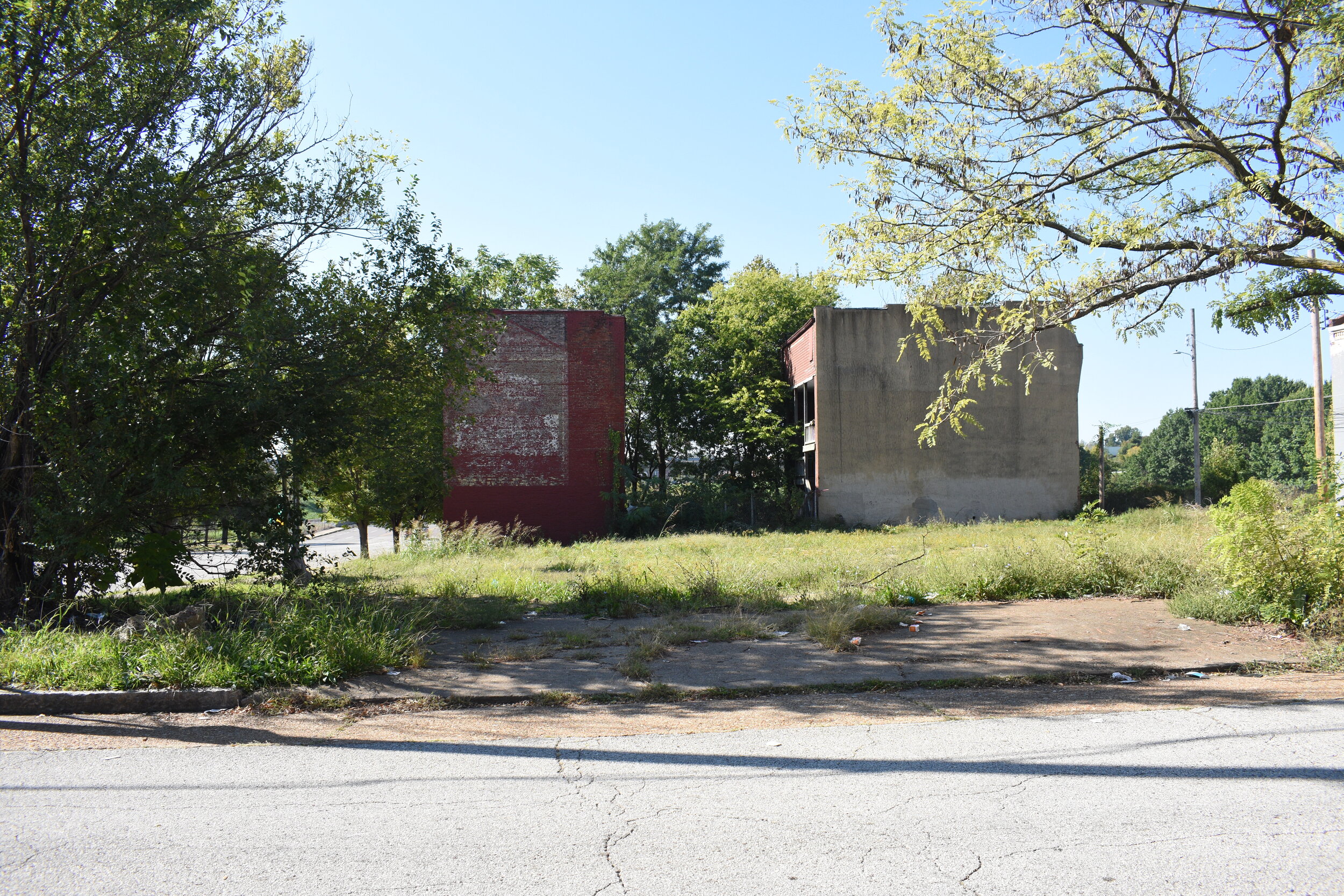Peabody Darst Webbe is a south St. Louis neighborhood bound by Tucker Boulevard/12th Street to the east, Dolman Street to the west, Chouteau Avenue to the north and I-55/I-44 to the south:
I always thought Truman Parkway was the border between Peabody Darst Webbe and Lafayette Square. Not so.
The 2000 census counted 1,460 residents (a whopping 44% decrease from 1990's count) of whom 96% were black, 3% white and 1% Hispanic/Latino. There were only 779 housing units counted, 72% of which were occupied. 97% rental, 3% owner occupied. The neighborhood saw a 61% gain in population per the 2010 census data! 88% black, 10% white, 1% Hispanic/Latino. The 2020 Census saw a gain of 65 residents and 91 housing units. Vacancy dropped by 52 units. Good news all around. The racial data saw some changes as it diversifies. Asian population doubled, Hispanic/Latino tripled, but the neighborhood is still largely Black and white at 80% and 15%, respectively.
So this neighborhood can be broken down into 3 main areas:
1) the small area between Dolman Street and Truman Parkway
2) the area of subsidized housing taking up the majority of the neighborhood
3) the area consisting of the former city hospital property and Bohemian Hill area just south of Lafayette Avenue.
I'll start with the row of houses and fallow grounds between Dolman Street and Truman Parkway. Literally speaking the area east of Dolman is Peabody Darst Webbe territory, but for all practical purposes, this area should be considered part of Lafayette Square. In fact the city or the Lafayette Square neighborhood organization have erected a fence to physically separate Lafayette from it's eastern neighbors in PDW.

There are a handful of really well done rehabs of Victorian beauties and row houses, a church, some new construction as well as the art deco Eden building recently renovated into lofts:









If you like the Eden building as much as I do, here's a brief history (source):
The Eden Loft building was originally constructed to house the Eden Publishing House in 1896 and is now listed on the National Register of Historic Places. A few weeks after opening, the Great Cyclone of 1896 damaged the building and contents, but was quickly repaired and remained relatively unchanged, save for a few additions, for three decades.
In 1929 architects Hoener, Baum and Froese were commissioned to design the current five-story Synod building in the Art Deco Style located immediately west of the original structure. The addition housed the retail store, administrative and executive offices. The modernist design of the addition was carried over to the original three-story building with a new brick and terra cotta facade.
Over the next 40 years, the building was in continuous use until an economic decline during the 1960s and 1970s caused Eden Publishing to abruptly close its operations in 1978. The building sat empty for several years and was listed in the National Register of Historic Places in 1986 for its unique architecture and historic heritage. Today, the grandeur of the Eden building is being preserved through an extensive conversion into unique residences known as Eden Lofts. Experience turn-of-the century architecture and St. Louis history today in the Eden Lofts—perfectly situated, central living in Lafayette Square.
Some new construction is happening east of Dolman Street and south of Park Avenue where the former Ender's Auto Service existed for years.

Before

Current project underway
I will update this entry with an "after" picture once the project is completed.
The unfortunate fact is that this swath of land between Dolman and Truman has a lot of fallow ground waiting for new infill or other use:

The second and largest area of the neighborhood is the subsidized housing section owned by the St. Louis Housing Authority. This is where the neighborhood got it's name.
An interesting quote/commentary from the scant Peabody Darst Webbe link on the city website:
Yes, you know us for those bombed-out high-rise public housing projects. We agree. They should have been demolished years ago. But we are also about 600 families and 300 seniors who care about our families and are proud of our neighborhood school. We actively support a local health clinic and two community service centers. We participate in four public housing tenant boards. We are eagerly anticipating the day when the old buildings come down, and the new ones go up, in the Darst-Webbe Urban Revitalization District: right here, in the Near Southside.....
I like the honesty; but the site could use an update. The high rises that once existed here are indeed gone (thank goodness). Both the Malcolm Bliss Psychiatric Ward (which was cool looking, but pretty creepy when abandoned) and the Darst and Webbe high rises have been razed. This place used to scare the #$%& out of me as a kid. I imagined it was crawling with people straight outta the Warriors; it rocked my suburban sensibilities at the time and left a lasting impression.

Neglect and ridiculous anti-social behavior provided for a pretty creepy, post-apocalyptic backdrop to this part of town.
There is an excellent write up of the high rise complexes at UrbanReviewSTL as well as this photo:

Photo from www.urbanreviewstl.com
Here's another perspective from Pamela C. Liles:




Photos from http://pcliles.blogspot.com
Here are some more demo pictures from Songbill's Flikr page from 2000:


Things are better today...at least appear to be. I still think we have a "warehouse the poor" policy, but instead of vertical, the thought is more "neighborhood-like" and mixed with owner-occupied properties. Certainly, this seems a more palatable approach for the average observer.
Whatever your opinions on the poor and centralizing poor into pockets of the city, here's what you'll see today in place of the mid-century towers:














Say what you will regarding the design and construction materials chosen, but the area is pretty clean and landscaped and maintained. It's a drastic improvement over what existed before, no?
There are a couple institutions in this part of the neighborhood including the mid-century modern Peabody School:




Finally, the other looming presence in Peabody Darst Webbe is the former St. Louis City Hospital site.

Here's the sprawling property today:

There is an excellent, detailed history of the hospital complex by Michael Allen here.
The former hospital buildings that remain are being carefully restored and brought back to life as the Georgian and the swanky Palladium events hall. This place is simply an awesome reuse of classic old buildings. I last reported on the Georgian back in July, 2009 and oh what a difference a year and a half makes in ole St. Lou. The boarded up windows have been replaced with beautiful new ones and the renovations are underway.




Here's one example of the progress that has gone on at the site:

before

after
There is also news of a recent development proposal that I am particularly excited about, the Sappington Farmer's Market at the southern edge of the neighborhood where Malcolm Bliss once stood:

From a February, 2010 Riverfront Times blog entry:
The farmer-owners of Sappington Farmers' Market have plans to open a new store near downtown St. Louis, on the southeast corner of Park Avenue and Truman Parkway.
Randy Wood, one of the owners of the local-foods purveyor, says the new store will feature 25,000 square feet of retail space on the ground floor, a processing facility on the second floor and an 80,000-square-foot greenhouse atop the building.
"We'll grow produce on the roof, take it down and process it in the second floor, then drop it down another floor to sell it," says Wood. "Initially it'll be a flash-freeze operation for fruits and vegetables. But I'm talking to a couple other food processors in the city about a joint venture opportunity to do maybe pasta sauces and salsas, and other value-added food processing."
Wood says he and his business partners chose the spot -- just east of the ritzy Lafayette Square and just south of the Clinton-Peabody housing project -- because it sits at a socioeconomic crossroads.
As Wood puts it, "We don't want it to be a Whole Foods. We don't want to price anybody out." Produce, dairy and meat from local farmers will make up the bulk of the stock.
The group hopes to have architectural and financing plans in place by the end of the year in order to break ground during the first part of 2011.
Wood and his partners purchased the Sappington Farmers' Market, on Watson Road, back in mid-2008 and have been revitalizing the inventory to feature more local and organic foods.
Can I get a hell yes? While not a fan of organic (insane price premiums, lo-fi/no-tech approach), I love the local food idea and a civilized grocery store to service this part of town. Let's keep our fingers crossed on this one.
The area south of Lafayette Avenue nearest the Interstate 55 and 44 convergence is referred to as Bohemian Hill. This area has largely been clear cut, but there is still some original and newer housing that exists nearest 12th Street:




A proposal for a Starbucks, grocery store and other retails outlets was floated for this area as far back as January, 2007.



This project is most likely dead in the water, spare the Walgreens that did get built:
Peabody Darst Webbe has made quite a comeback since the 1990's when the neighborhood had probably hit rock bottom. Here's to continued growth at the Georgian and Bohemian Hill area!
***In October, 2021 I revisited the neighborhood and the following includes updated commentary and photos.***
Misses On Original Tour
No real misses other than my misspelling of Dolman Street. Also, I failed to point out the Al Chappelle Community Center, which is a St. Louis Housing Authority operation that is a public space with meeting rooms, etc. with the goal of connecting residents with job opportunities.
Noticeable Changes
Lots of changes occurred over the last decade. First, the east side of Dolman Street has seen much fantastic, high end infill and rehabbing. There was a long vacant mop factory building at Dolman and Park that was renovated into apartments called the Bordeaux.
Several homes have been added that fill in the gaps and match their old neighbors nearly perfectly. You have to inspect the foundations to correctly identify the new ones vs. the few remaining classics. I’m still in awe, this could be a national example of quality historic infill. It takes $ and standards. Here is an example of what high end historic construction can bring. And, they rebuilt the alleys behind these beauties to match the big city look and feel of the rest of the neighborhood.
There are still some vacant lots that will hopefully see the same treatment and finish the street wall.
Several new homes have been added to the central section of the neighborhood. Some of these are Habitat for Humanity homes.You can read about the project in the Additional Reading section below. Here are a couple example of the newer homes.
Note the fact that the additions were rather low-density, where you could have built two new homes without the unnecessarily large gaps on the sides. While it is an improvement over vacant lots, it was a missed opportunity to build an urban street wall and get more folks in the neighborhood.
The Sappington Farmer’s Market project mentioned in the original post never materialized, but there was a new dental school constructed in this part of the neighborhood called A.T. Still University-Missouri School of Dentistry & Oral Health. Nice.
The former city hospital property has also seen some additional rehabbing and units added.
There is a rock climbing gym and restaurant with a rooftop bar as part of this area as well.
There is now a charter school called Kipp Wisdom Academy with ~500 K-grade 4 students. These charter schools tend to come and go, there used to be a Kipp in my neighborhood, but they tend to move around.
The shopping area just south of Lafayette Avenue now includes a Fields Foods grocery store and Walgreens. There was a Tim Hortons donut shop, but all local Hortons chains closed and it has been empty ever since.
What Are The Future Needs?
In my opinion the two biggest areas of improvement would be more infill in the center of the neighborhood (which could happen), and the area of Bohemian Hill on the southeast corner of the neighborhood at Lafayette and Tucker needs to be sold to capable developers for infill and rehabs (likely won’t happen). The area is a fantastic place to live and should be developed. Why this sits vacant and abandoned decade after decade is a mystery to me. The vacant lots are owned by a patchwork of mostly out of town investors, several of whom have not paid their 2020 property taxes per Geo St. Louis. This sits across from some of the most desirable places to live in St. Louis, and the fact that it remains underutilized with high vacancy is a mystery to me. Illegal dumping is in full effect, giving the finger to the residents who live here.
While it is thrilling to see Habitat for Humanity building new homes, there are still some vacant lots that can see some dense housing added to build out the neighborhood.
I’d also like to see a less low-value suburban land use for the former Tim Hortons and copious surface parking near the Walgreens. Let me tell you, the parking lot is almost never full, I am here all the time, I go here to teach my kids how to park with no traffic. You could add a couple new buildings and make it look much better from Lafayette. The rendering for the development is nothing like what was actually built. We got hosed.
The Walgreens and Fields Foods are needed resources for the neighborhoods surrounding them, and the Walgreens is at least somewhat built toward the sidewalk along Lafayette, but the low density and overly large parking lot could use at least a couple more buildings.
Pedestrian crossing should be prioritized between the residential areas to the north and the Walgreens and Fields Foods. During rush hour, the driving habits of those seeking to get on the Interstates is intense and there are a lot of kids that walk to these places.
And Lafayette Square, please get rid of that fence along the western side of Thurman. That makes residents of Lafayette Square look like bad neighbors. We need to move beyond stuff like that.
Additional St. Louis City Talk Reading
Infill Continues in Peabody Darst Webbe & Lafayette Square Neighborhoods - April, 2019
Revisiting the Former City Hospital Site in Peabody Darst Webbe Neighborhood - April, 2019
Ten New Homes in the Peabody Darst Webbe Neighborhood - August, 2019
Dolman Street Returning to Residential vs. Vacant Lots - August, 2017




